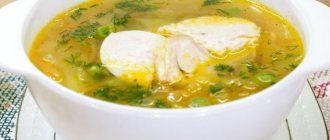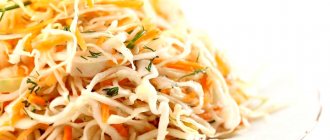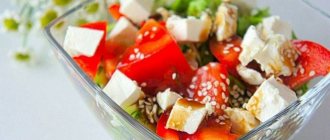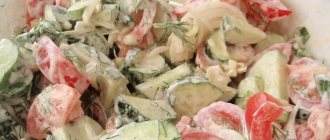Description of appearance and variety
This moisture-loving and light-loving plant is most often planted using seedlings. The most favorable place for planting will be beds where cucumbers, beans, peas or potatoes previously grew.
- The leaves of this vegetable fit tightly to each other, forming a basal rosette.
- Leaf color can range from bright white to deep green.
- Depending on the variety, the head of cabbage ripens from one and a half to three months.
- Inside the head of cabbage there is a stalk, which is also suitable for consumption.
- The fruit of cabbage is an elongated pod containing brown seeds.
Due to its high yield and frost resistance, the vegetable has gained extreme popularity in all Northern European countries. It is not for nothing that the national cuisines of most European nations contain so many dishes made from cabbage, the nutritional value of which is of great importance for the inhabitants of the north.
The best varieties
The most popular types of white cabbage are the following varieties:
- “Stakhanovka”, which has fairly large heads of cabbage that are resistant to cracking. It has excellent yield, and the taste of the leaves is soft and sweet.
- The early ripening variety “Gribovsky” produces small heads of cabbage, weighing barely one kilogram. The leaves are a little harsh and tightly pressed. This vegetable is suitable for preparing fresh salads and is completely unsuitable for pickling.
- Cabbage "Slava" has flattened heads, the weight of which can reach 5 kg. It stores quite well and is often used to make pickles.
- As for winter pickling, the Krasnodar variety is best suited. The thick leaves of this cabbage release a lot of sweet juice. They are loosely pressed and have a pleasant, greenish tint. The beneficial composition and nutritional value of cabbage of this variety significantly exceeds others.
- The Amager variety is intended for winter storage in the basement or on the balcony. It is suitable for use for 7-8 months and does not lose its qualities until spring.
In terms of their nutritional value, cabbage heads may differ slightly from each other depending on the variety, but in general they have the same qualities and beneficial effects.
Chemical composition of cabbage
The nutritional value and benefits of this vegetable are difficult to overestimate. It has an unusually rich composition, which includes a huge amount of vitamins, microelements and other useful substances. Each of them has its own properties:
- First of all, white cabbage is an excellent supplier of vitamin C, which is found in quite decent quantities in its composition. In addition, this vegetable has the unique ability to preserve such an important vitamin until spring. Sauerkraut, salted or pickled cabbage is a powerful immunostimulant that supports the body during flu epidemics and colds.
- Antioxidant group of vitamins: A and E are also present in cabbage in fairly decent quantities. They prevent premature aging and promote cell renewal of tissues of all internal organs.
- Cabbage also contains rare vitamin U, which prevents the formation of stomach ulcers. Regular consumption of this vegetable leads to healthier gastrointestinal tract organs and promotes healing of the mucous membrane.
- There is a lot of potassium in white cabbage. This microelement is necessary for the normal functioning of the heart muscle and ensuring proper metabolism.
- Vitamin B7, better known as biotin, improves skin and hair condition. Women who choose to regularly consume fresh cabbage usually have healthy, fresh skin and shiny hair.
- In second place in terms of the content of useful microelements is calcium, which strengthens bone mass and phosphorus, which is responsible for the health of teeth and joints.
Of the remaining trace elements, cabbage contains magnesium, zinc, selenium, iron and sodium.
Video of cauliflower puree soup
The calorie content of fresh white cabbage per 100 grams is 28 kcal. 100 g of vegetable contains:
- 1.8 g protein;
- 0.2 g fat;
- 4.75 g carbohydrates.
The product is saturated with beta carotene, thiamine, riboflavin, pyridoxine, vitamins C, K, PP, potassium, calcium, magnesium, sodium, phosphorus, chlorine, iron, iodine, cobalt, manganese, copper, molybdenum, chromium, zinc.
The calorie content of fresh cabbage and carrot salad per 100 grams is 50.1 kcal. 100 g of dish contains 1.5 g of protein, 1.8 g of fat, 7.1 g of carbohydrates. To prepare the salad you need:
- 0.3 kg of fresh white cabbage;
- 0.15 kg of fresh carrots;
- 7 g sunflower oil;
- 12 g bite;
- 10 g granulated sugar.
Salad preparation steps:
- finely shredded cabbage is salted and crushed by hand;
- carrots are grated and mixed with cabbage;
- the mixture is seasoned with vinegar, mixed with sugar and 7 grams of vegetable oil.
What is the value of cabbage
One hundred grams of the product contains two and a half grams of dietary fiber, 1.30 g. protein and only 5.9 carbs. The nutritional value of white cabbage is about 26 kcal. Broccoli contains a little more calories, and Brussels sprouts have the largest amount. One hundred grams of this vegetable contains more than 40 kcal. Among all vegetables, cucumbers, radishes and tomatoes have the least amount of energy value, and parsnips have the highest.
Cabbage contains a lot of water and sucrose, but very little pectin. The proteins of this vegetable contain a considerable amount of sulfur. Cabbage is also rich in nitrogenous and fat-like substances, which stimulate gastric motility and effectively cleanse the large intestine of feces.
How many calories are in white cabbage?
The calorie content of fresh white cabbage, however, like all vegetables, is low and amounts to:
27 kcal per 100 grams of product
Proteins, fats and carbohydrates (BJU) of fresh cabbage per 100 grams:
Proteins - 1.8
Fats – 0.1
Carbohydrates – 6.8
What is the calorie content of white cabbage prepared in different ways? And here it is:
Calorie table for white cabbage, per 100 grams of product:
| Cabbage | Calories, in kcal |
| stewed | 50,7 |
| fermented | 19,0 |
| boiled | 21,2 |
| for a couple | 27,0 |
| fried | 50,0 |
And the nutritional value of white cabbage, prepared in different ways, is this:
Table of nutritional value of white cabbage (BZHU), per 100 grams of product:
| Cabbage | Squirrels, gr. | Fats, gr. | Carbohydrates, gr. |
| stewed | 1,6 | 2,9 | 6,4 |
| pickled | 1,8 | 0,1 | 4,4 |
| boiled | 1,6 | 0,0 | 4,0 |
| for a couple | 1,8 | 0,8 | 6,8 |
| fried | 1,8 | 3,4 | 6,6 |
The low calorie content of cabbage is by no means the most important of all its positive qualities. The main property that sets it apart from other vegetable crops is its beneficial effect on digestive disorders and ailments of the gastrointestinal tract.
Cauliflower
This vegetable contains a huge amount of vitamin A compared to white cabbage. The nutritional value of cauliflower exceeds the rest. According to research, the figure is 1208 IU. Vitamins E and B9 are also contained in huge quantities, noticeably higher than in cabbage. This vegetable is rich in potassium, phosphorus and sodium. Cauliflower also contains increased amounts of selenium and magnesium.
Micro- and macroelements in white cabbage
White cabbage contains the following elements: Mono- and disaccharides, Ash, Starch, Water, Dietary fiber, Sodium, Potassium, Phosphorus, Magnesium, Calcium, Sulfur, Copper, Boron, Aluminum, Iodine, Manganese, Chromium, Fluorine, Molybdenum, Cobalt, Nickel, Selenium, Zinc, Iron, Chlorine.
Micro- and macroelementValue
| Mono- and disaccharides, g. | 4,6 |
| Zola, Mr. | 0,7 |
| Starch, Mr. | 0,1 |
| Water, city | 90,4 |
| Dietary fiber, g. | 2 |
| Sodium, mg | 13 |
| Potassium, mg | 300 |
| Phosphorus, mg | 31 |
| Magnesium, mg | 16 |
| Calcium, mg | 48 |
| Sulfur, mg | 37 |
| Copper, µg | 75 |
| Boron, µg | 200 |
| Aluminum, µg | 570 |
| Iodine, mcg | 3 |
| Manganese, mg | 0,17 |
| Chromium, µg | 5 |
| Fluorine, mcg | 10 |
| Molybdenum, mcg | 10 |
| Cobalt, µg | 3 |
| Nickel, µg | 15 |
| Selenium, mcg | 0,3 |
| Zinc, mg | 0,4 |
| Iron, mg | 0,6 |
| Chlorine, mg | 37 |
Sea kale
In fact, seaweed is ordinary algae, otherwise called kelp. There are about 30 species in total that are quite edible. This product is the basis of nutrition for all peoples living in areas where these algae grow. The nutritional value of seaweed for the human body is extremely high. This is a unique and natural source of iodine, which is vital for a person throughout his life. Seaweed is not only consumed as food, it is also used to prepare cosmetic products and is processed into oil.
It contains almost all microelements and vitamins known today. The largest amounts are vitamin A, B9, a and B1. Among the microelements, sodium, magnesium and calcium are most represented.
What are the benefits of white cabbage?
- Vitamin C
is involved in redox reactions, the functioning of the immune system, and promotes the absorption of iron. Deficiency leads to loose and bleeding gums, nosebleeds due to increased permeability and fragility of blood capillaries. - Vitamin K
regulates blood clotting. A lack of vitamin K leads to an increase in blood clotting time and a decreased level of prothrombin in the blood. - Potassium
is the main intracellular ion that takes part in the regulation of water, acid and electrolyte balance, and is involved in the processes of conducting nerve impulses and regulating blood pressure. - Silicon
is included as a structural component in glycosaminoglycans and stimulates collagen synthesis. - Cobalt
is part of vitamin B12. Activates enzymes of fatty acid metabolism and folic acid metabolism. - Molybdenum
is a cofactor for many enzymes that ensure the metabolism of sulfur-containing amino acids, purines and pyrimidines.
still hide
You can see a complete guide to the healthiest foods in the “My Healthy Diet” app.
- home
- Product composition
- Composition vegetables and herbs
- Chemical composition of “White cabbage”
Tags:
White cabbage calorie content 28 kcal, chemical composition, nutritional value, vitamins, minerals, benefits White cabbage, calories, nutrients, beneficial properties White cabbage
Energy value, or calorie content
- this is the amount of energy released in the human body from food during the digestion process. The energy value of the product is measured in kilocalories (kcal) or kilojoules (kJ) per 100 grams. product. The kilocalorie used to measure the energy value of food is also called a food calorie, so when caloric content is reported in (kilo)calories, the prefix kilo is often omitted. You can see detailed energy value tables for Russian products here.
The nutritional value
— content of carbohydrates, fats and proteins in the product.
Nutritional value of food product
- a set of properties of a food product, in the presence of which the physiological needs of a person for the necessary substances and energy are satisfied.
Vitamins
, organic substances required in small quantities in the diet of both humans and most vertebrates. Vitamin synthesis is usually carried out by plants, not animals. A person's daily requirement for vitamins is only a few milligrams or micrograms. Unlike inorganic substances, vitamins are destroyed by strong heat. Many vitamins are unstable and are “lost” during cooking or food processing.
source
Benefits of cabbage
Sauerkraut has oxidative properties, perfectly eliminates toxicosis in pregnant women and helps restore water-salt balance when the body is poisoned by toxins from the breakdown of alcohol. When fermented, the amount of vitamin C increases noticeably, and some of it goes into the brine. Therefore, sauerkraut is considered a more immunostimulating product compared to fresh vegetables.
However, this vegetable is useful in any form. At all times, people have used the cleansing properties of cabbage to get rid of toxins and stagnant feces. Those who have stomach problems are highly recommended to eat dishes made from this vegetable. With the help of cabbage juice, you can quickly and effectively heal ulcerative erosions on the gastric mucosa, as well as stop the inflammatory process in the pancreas.
Cabbage leaves are applied to sore knees for arthritis and arthrosis, and are also used in the treatment of bronchitis, otitis media and pneumonia.
Cabbage has proven itself to be excellent in the treatment of mastitis in women. The sheet is smeared on one side with honey and applied to the chest overnight. The next morning, as a rule, the hardening disappears.
It is highly not recommended to consume dishes from this vegetable in case of acute pancreatitis, dysbacteriosis and bleeding in the stomach.










